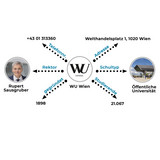Industry 5.0: A co-worker called AI
Artificial intelligence could help make manufacturing work safer, easier, and more productive. This is the idea behind the EU-funded PERKS research project, in which researchers from WU (Vienna University of Economics and Business) play a pivotal role.
A great deal of procedural knowledge is required to ensure that a factory runs smoothly: Numerous tasks and processes are needed to operate and maintain machines – and most of these tasks are carried out in a seemingly automatic manner in day-to-day operations. The amount of know-how required for each task only becomes clear when key employees are absent or when new employees need to be trained. “This know-how is often difficult to explain, and it’s not always documented properly,” says Marta Sabou, Head of the Institute for Data, Process and Knowledge Management at WU. “And even if it’s written down somewhere, the question is whether you can find it when you need it.”
This is exactly what the EU-funded PERKS research project sets out to achieve: to better document this know-how and make it more easily accessible. Together with eight industry and research partners, including Siemens and Whirlpool, the researchers look into the possibilities of artificial intelligence for making manufacturing work easier, safer, and more productive.
“Alexa, help me with the maintenance work”
But how is this supposed to work? Marta Sabou explains it using an example from project partner Whirlpool’s white goods factory in Italy: “The machines that are used in production must be switched off correctly when they are cleaned, maintained, and repaired. There is a specific procedure for that, the LOTO or log-out-tag-out procedure. It consists of a precise sequence of steps that must be followed to ensure the safety of the workers.” The instructions for this procedure are sometimes documented on paper, sometimes in PDFs or in other files – but crucial details are often stored only in the heads of the workers who have years of experience operating a specific machine.
Marta Sabou and her PERKS colleagues are now developing an artificial intelligence that collects and organizes all this information using natural language processing (NLP). “It works in a way similar to ChatGPT, but it’s specifically optimized for procedural knowledge.”
The next step is to make this knowledge available to workers in as simple a form as possible. For example, the Austrian company Onlim is developing a chatbot which new employees can consult if they need help operating a machine. “However, you could also have an assistance system that guides you through the individual work steps with a voice like Alexa or Siri,” adds Marta Sabou, “or perhaps even a robot that can explain in its own words how it needs to be serviced.”
Focusing on people
The PERKS project is an example of research in a new field known as “Industry 5.0”: “When the Industry 4.0 concept was introduced about ten years ago, it was mainly about automation and increasing efficiency – in other words, removing people as a factor in manufacturing processes,” says Marta Sabou from WU. Industry 5.0 aims for the opposite: putting people at the center. The goal of PERKS is not just to improve knowledge transfer and increase efficiency. It is also about reducing the risk of accidents and avoiding tedious paperwork: “We want to use technology to support people and make their work safer and, on the whole, more pleasant.”
Whether these goals can be achieved will become clear at the end of the 30-month project. The first results are expected for 2025.
Further information on the project
Website of the EU-funded PERKS research project


![[Translate to English:] Portraitfoto von Marta Sabou](/fileadmin/wu/_processed_/0/f/csm_martasabou_quadrat_961c898091.png)
![[Translate to English:] Portraitfoto von Jan Maly](/fileadmin/wu/_processed_/c/8/csm_janmaly_website_2_7110fbd501.jpg)
![[Translate to English:] Foto Axel Polleres](/fileadmin/wu/_processed_/5/3/csm_AxelPolleres_512bc2d7d5.jpg)